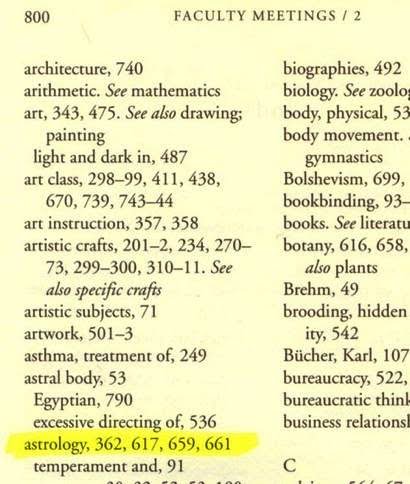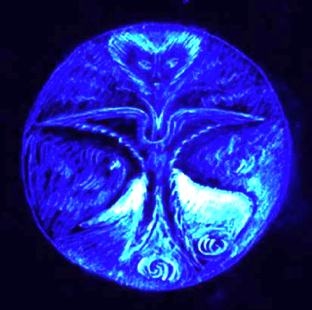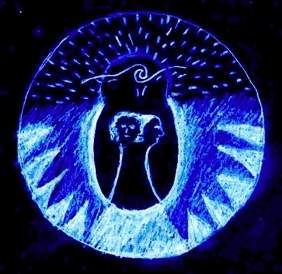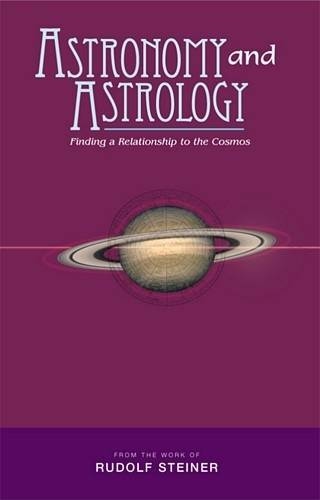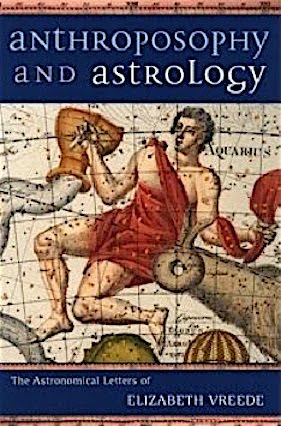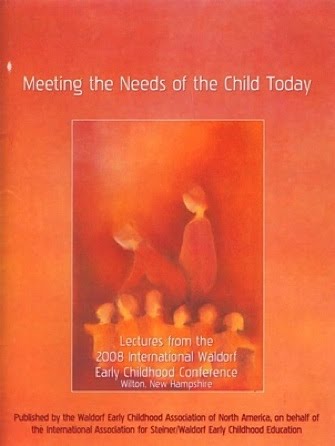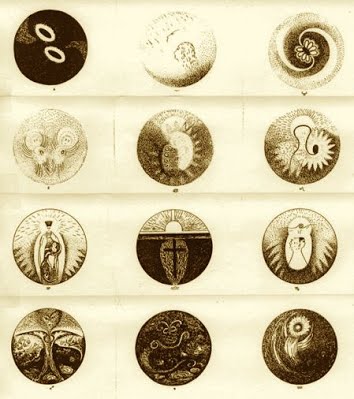◊ “[T]he old, real, and genuine Astrology expresses itself in the destinies of men.” — Rudolf Steiner, ROSICRUCIANISM AND MODERN INITIATION (Rudolf Steiner Press, 1965), lecture 3, GA 233a.
◊ "The fixed stars work in the human being, the moving planets work in the human being...." — Rudolf Steiner, THE ROOTS OF EDUCATION (Anthroposophic Press, 1997), p. 84.
◊ "It's a very common practice for Waldorf teachers to do an astrological chart on incoming students." — Middlearthmama, Mothering.com
On the page "Star Power," we looked at astological beliefs that work their way into the Waldorf mindset. [See "Star Power".] Let's take this subject a little further.
During
several faculty meetings at the first Waldorf school, Rudolf Steiner
discussed astrological subjects with Waldorf teachers. These were not
abstract, academic discussions. Steiner was expressing his astrological
beliefs. Such beliefs lie behind many practices at Waldorf schools.
Here
are passages recording Steiner’s statements. The editors of FACULTY
MEETINGS WITH RUDOLF STEINER (Anthroposophic Press, 1998) list these
passages under the index heading “astrology”.
In
the first passage, Steiner links “temperament” to astrological sign.
This is revealing. Waldorf teachers often categorize their students
according to the antiquated and wholly discredited system of
“temperaments” that were once believed to be caused by “bodily humours”.
[See “Humoresque”. and "Temperaments".]
Here we see that the irrationality of this approach is heightened by
the ties Waldorf faculty trace between temperament and the influence of
the stars.
“In
cholerics, you will probably generally find an abnormally developed
sense of balance (Libra) and an external display of that in the ear
canal through an autopsy. The experience of rhythm, the sense of balance
and sense of movement, the interaction of these, rhythmic experience.
In sanguines (Virgo), in connection with the sense of balance and sense
of movement, the sense of movement predominates. In the same way, in
melancholics (Leo) the sense of life predominates and in phlegmatics
(Cancer) the sense of touch predominates physiologically because the
touch bodies are embedded in small fat pads. That is physiologically
demonstrable.” — Rudolf Steiner, FACULTY MEETINGS WITH RUDOLF STEINER, p. 91.
In
the second passage, Steiner’s wife Marie recommends that the assembled
Waldorf teachers read her husband’s lecture "The Twelve Moods". Rudolf
himself then explicitly links the book to astrology. (Indeed, in the
book, Steiner claims that there are twelve identifiable human moods,
each of which can be identified by one of the twelve astrological signs.
He did this kind of thing with all sorts of phenomena, breaking them
into groups of twelve, for the signs of the zodiac, or into groups of
seven, for the seven “sacred planets”.) Note that Steiner says Waldorf
teachers “can use” the link between moods and astrology when they teach
various subjects.
“Marie Steiner: I would recommend Dr. Steiner’s Twelve Moods.
“Dr. Steiner:
The Twelve Moods were once tested in connection with astrology. They
are cosmically connected. That is something you can use both in the
teaching of style and in eurythmy.” — Ibid., p. 362.
Next
we find Steiner stating one of his more bizarre clairvoyant “insights”:
The continents float and are held in place by the power of the stars.
Indeed, Steiner often taught — and Waldorf teachers believe — that the
stars, constellations, and planets exert enormous forces upon the Earth,
forces that science cannot detect but that clairvoyants such as Steiner
recognize.
“Usually
people do not think about how it looks if you move toward the center of
the Earth. You would soon come to regions where it is very fluid,
whether it is water or something else. Thus, according to our normal
understanding, the continents swim. The question is, of course, why they
don’t bump into one another, why they don’t move back and forth, and
why they are always the same distance from one another, since the Earth
is under all kinds of influences. Why don’t they bump into one another?
For instance, why is a channel always the same width? We can find no
explanation for that from within the Earth. That is something that comes
from outside. All fixed land swims and the stars hold it in position.
Otherwise, everything would break apart. The seas tend to be spherical.
“The
contrast is interesting. The continents swim and do not sit upon
anything. They are held in position upon the Earth by the
constellations. When the constellations change, the continents change,
also. The old tellurians and atlases properly included the
constellations of the zodiac in relationship to the configuration of the
Earth’s surface. The continents are held from the periphery; the higher
realms hold the parts of the Earth. In contrast, the Earth holds the
Moon dynamically, as if on a leash. The Moon goes along as if on a
tether.” — Ibid., pp. 617-618.
Steiner
also tells the assembled Waldorf teachers to discuss the zodiac with
their students. This might be harmless, if we were sure that Waldorf
teachers do not believe in the astrological powers of the zodiac. But
because we know just the opposite — that many Waldorf teachers do
believe in astrological powers — red flags begin to wave. Thus, devout
Waldorf faculty will teach the students not about ancient superstition
that should be repudiated, but about ancient occult beliefs that should
be embraced as truth.
In
particular, Steiner tells Waldorf teachers to lay out the astrological
signs appropriate for each type of animal. There is no reason for doing
this except that Steiner and his followers believe that the stars
literally influence and even control various animals.
“In
discussing the zodiac, you should begin with the mammals, represented
by Leo; then birds, Virgo; reptiles, Libra; amphibians, Scorpio; fish,
Sagittarius; articulates, Capricorn; worms, Aquarius. Then continue on
the other side, where you have the protists, Cancer; corals, Gemini;
echinoderms, Taurus; ascidians, Aries; mollusks, Pisces. You should
realize that the zodiac arose at a time when the names and
classifications were very different. In the Hebrew language, there is no
word for fish, so it is quite reasonable that you would not find fish
mentioned in the story of creation. They were seen as birds that lived
in water. Thus, the zodiac is divided in this way, into seven and five
parts for day and night.” — Ibid., pp. 659-660.
A
few paragraphs later, Steiner returns again to his astrological theme.
Note that he explicitly states his doctrine that the forces of the
zodiac are projected onto the Earth. And he tells the Waldorf teachers
that globes — celestial or zodiacal globes — showing the connections
between the zodiac and the Earth will provide what they need to teach
“animal geography” properly. Thus, astrology would again enter the
classroom.
“When
teaching animal geography, you need to consider the zodiac in
connection with what I have just said, that is, look at the projection
of the zodiac upon the Earth. You will then find the areas of the animal
groups on the Earth. You have some globes where the zodiac is drawn
upon the Earth. They will provide you with what you need.” — Ibid., p.
661.
  
The
Waldorf take of astrology shows up in other Waldorf books besides
FACULTY MEETINGS WITH RUDOLF STEINER. In the following passage, for
instance, we find Steiner speaking about the “spiritual forces” that
stream down from the Sun. This is the central concept of astrology, that
celestial objects project spiritual powers onto the Earth. The book in
question here is ESSENTIALS OF EDUCATION (Anthroposophic Press,
1997).
Yes,
the Sun's rays come down to the Earth. But do these rays include
astrological, "spiritual" components? How can we know? How could Steiner
know? He couldn't. But he insisted that he could. But let that go.
Let's say that he could know and did know. The only point
we need to consider at this moment is whether you agree with him and
want to choose people who agree with him to be your children's teachers.
What Steiner is saying here is that the Sun sends magical astrological
influences to the Earth and this is important in the growth of plants.
Do you agree?
“The
Sun is not merely what is described by astronomy and spectrum analysis;
with the Sun’s rays, spiritual forces stream and interweave down to the
Earth. In this ensoulment of sunlight we have the element that, for
example, determines expansion in the growth of the plant." — Rudolf
Steiner, ESSENTIALS OF EDUCATION (Anthroposophic Press, 1997), p. 56.
Next,
in THE ROOTS OF EDUCATION (Anthroposophic Press, 1997), we overhear
Steiner speaking again about the powers flowing down from above. Part of
what he says makes sense, or nearly so. The Sun certainly does send
down energy that affects life on Earth. But the Moon? And the stars?
Note that Steiner speaks of “Moon forces” and he says that the stars
“are at work in the plant.” This is nonsense, and doubly so because he
is not speaking of physical forces but astrological ones.
Note
that whereas, above, Steiner said that science is at least partly
right, here he tells us that science is really just about totally wrong.
He rejects real science — such as astronomy — and offers his occult
teachings in its place. Our liberation, he says — our passport into the
"distant spaces of the cosmos" — depends on our acceptance of occultism
(such as is provided by a certain R. Steiner) and our repudiation of the
foolish rational system called science. Astronomy has "lost sight of our relationship to the universe." But R. Steiner's version of astrology has not.
(P.S.
Steiner admired Goethe. But even Goethe was wrong about many things,
according to Steiner. If you want the real truth about anything, you
need to apply to the one unassailable source: R. Steiner. Or so R.
Steiner said.)
“Above
all, in the astronomical realm we have lost sight of our relationship
to the universe. If you look at a plant, you can see how it takes root
in the ground — how it arises from a seed, unfolds its first leaves and
stem, more leaves and a blossom, and how it then gathers itself together
again in the fruit. Goethe described it this way: In the plant you see
how it draws out into space, rotates, and then contracts. Goethe was
unable to go far enough. He described this expansion and contraction of
the plant, but could not come to the point of knowing why this happens.
It happens because the plant is exposed to the forces of the Moon and
Sun. Whenever the Sun’s forces are active, the plant expands and opens
its leaves; when Moon forces act on it, plant life contracts — it
develops the stem and then the seed, where the whole plant life is drawn
together in a single point. Thus, when we consider this expansion and
contraction as Goethe has shown it to us, we see in it the alternation
of Sun and Moon forces, and we are led out into the distant spaces of
the cosmos. When we can see how the stars are at work in the plant, we
do not remain bound and limited.” — Rudolf Steiner, THE ROOTS OF
EDUCATION (Anthroposophic Press, 1997), pp. 82-83.
The
following is a passage from DISCUSSIONS WITH TEACHERS (Anthroposophical
Press, 1997). The person heading the discussions is, of course, Rudolf
Steiner; the other participants are Waldorf teachers. Here, Steiner
indicates that “astronomical conditions” are important in the study of
geography. (Remember, the stars hold the continents in place.) By
implication, he also indicates that the stars affect human beings and
human ethnic groups. (In plain language, this means races.)
“In
geography, we continue with the study of astronomical conditions and
begin to cover the spiritual and cultural circumstances of Earth’s
inhabitants, of the various ethnic groups, but always in connection with
what the children have already learned about material cultural
circumstances — that is, economic circumstances — during their first two
years of geography lessons.” — Rudolf Steiner, DISCUSSIONS WITH
TEACHERS (Anthroposophic Press, 1997), pp. 191-192.
The "spiritual and cultural circumstances of Earth’s inhabitants" is directly related to "astronomical conditions" — or, in a word, astrology.
Steiner repeatedly taught that various human races are under the influence of astrological forces. For instance,
“We...find
there [i.e., in Asia] the Venus-race or the Malay race. We then pass on
across the wide domain of Asia and in the Mongolian race we find the
Mars-race. We then pass over into the domain of Europe and we find in
the Europeans, in their basic character, in their racial character, the
Jupiter men. If we cross over the ocean to America, where the place is
at which the races or civilizations die, we then find the race of the
dark Saturn, the original American-Indian race, the American race. The
American-Indian race is the Saturn race.” — Rudolf Steiner, THE MISSION
OF FOLK-SOULS (Anthroposophical Publishing Co., 1929), lecture 6, GA
121.
The stars influence human history and the inner condition of human experience, Steiner taught.
"People
can develop a strong will in the proper way only if we continue to
enlarge their perspective and direct them toward those things that act
spiritually in the world, those things coming from the stars that have a
spiritual effect upon world history and upon the
depths of the human heart." — Rudolf Steiner, THE RENEWAL OF EDUCATION
(Anthroposophic Press, 2001), p. 238.
The belief in "things coming from the stars that have a spiritual effect upon world history and upon the depths of the human heart" is, in a word, astrology.
The lines of influence run both ways, Steiner said. The stars affect us and we affect them.
"[H]uman
beings need a living spirit, one that permeates their souls, one that
can be found everywhere in history and which has an effect right up to
the stars." — Rudolf Steiner, THE RENEWAL OF EDUCATION, p. 239.
Steiner
found value and inspiration in the study of astrological influences,
and he said that Waldorf students will find similar value and
inspiration. He put a positive spin on his astrology, in other words.
Yet it remains astrology.
"You
will learn that what shines down from the moon and stars, what
expresses itself and reveals itself in this world that speaks to us when
the plants grow green and come up out of the earth in spring, what
reveals itself in deep valleys and in the shapes of mountains and in
minerals — that all this challenges us to lend a hand and bring forth
the best that we can. It challenges us to learn to understand something
about the world so that we can work in it." — Rudolf Steiner, RUDOLF
STEINER IN THE WALDORF SCHOOL (Anthroposophic Press, 1996), p. 107.
Note
that in this instance Steiner was directly addressing Waldorf students
("My dear children, today in this serious moment..." — p. 107.) So here
we have a particularly clear indication of astrology being taught to
kids attending a Waldorf school ("You will learn that what shines down from the moon and stars...").
Waldorf
astrology is part and parcel of the Waldorf belief that there are deep
spiritual ties between humanity and all of the surrounding universe.
This may be an appealing idea, but as Steiner formulates it, it is an
astrological idea.
"[T]he
human being is a mirror of the world; all the secrets of the universe
are contained in the human being. The fixed stars work in the human
being, the moving planets work in the human being, and all the elements of nature work there as well." — Rudolf Steiner, THE ROOTS OF EDUCATION, p. 84.
The stars work in us. The planets work in us. This is, in a word, astrology.
  
These
are doctrines that Rudolf Steiner propounded and that his followers —
many of whom teach in Waldorf schools — embrace. Whether astrology
surfaces in any particular Waldorf class depends on the specific Waldorf
teacher and school in question. But astrological beliefs undeniably
lurk below the surface (and sometimes just barely below the surface) of
Waldorf pedagogy.
For more on these matters, see
“Star Power”,
“Astrology”,
“Astrosophy”,
"Zodiac",
and
“Horoscopes.”
  
"By looking at what the horoscope shows we can see what is really the matter [with a child]. Take first this horoscope (of the elder sister). It will probably have struck you that you find here in this region, Uranus together with Venus and Mars. You will not really need to carry your considerations any further than this triangle. Here then are Mars, Venus and Uranus. Consider first Mars. For this child, who was born in 1909, Mars stands in complete opposition to the Moon. Mars, which has Venus and Uranus in its vicinity, stands — itself — in strong opposition to the Moon. Here is the Moon and here is Mars. And Mars pulls along with it Uranus and Venus...." — Rudolf Steiner, CURATIVE EDUCATION (Rudolf Steiner Press, 1972), lecture 11, GA 317.
  
Here are passages from other Anthroposophical texts bearing on Waldorf astrology.
"From
each region of the zodiac and from the planets there stream to Earth
certain forces and these forces become manifest in the physical being of
man ... According to the position of the Sun and zodiac, modified by
the relationship to the planets, a person receives specific forces at
birth ... They are given to him as an endowment." — Waldorf teacher Roy Wilkinson, RUDOLF STEINER (Temple Lodge Publishing, 2005), pp. 43-44.
“Each
region of the zodiac can be looked upon as the home
of particular spiritual beings and a centre of forces. There are 12
signs of the zodiac and 12 corresponding parts off the human
organism ... While the forces of the zodiac correspond to the human
physical structure, the planets and their forces are mirrored in
the internal organs." — Roy Wilkinson, THE SPIRITUAL BASIS OF STEINER EDUCATION (Rudolf Steiner Press, 1996), p. 47.
“Astrological
chart — A map of the soul’s revelation as it unfolds consciousness
through the element of time. Higher spiritual beings reveal their
influence, in ebb and flow, through the movement of the planets with
stars and constellations as backdrop.”* — Waldorf teacher Ron Odama, ASTROLOGY AND ANTHROPOSOPHY (Bennett & Hastings Publishing, 2009), p. 12.
*
Horoscopes or astrological charts are rarely displayed openly in
Waldorf schools, but — as we saw, above — Steiner himself sometimes made
use of horoscopes ("By looking at what the horoscope shows we can see what is really the matter [with a child]...").

“Twelve particular constellations, known as the zodiac...have
a particular formative presence in our universe. Their relative
movements can be experienced as an ever-changing dance or conversation
... In long distant ages we could experience fellowship with the
beings of the starry world, and addressed them as gods and goddesses ...
Out of his spiritual research, Rudolf Steiner also recognized the
living quality of the zodiac circle. He experienced it speaking or
singing to us, and perceived that a specific consonant...sounds out of
each sign of the zodiac ... Likewise, each of the planets sings to the
earth with a different vowel quality.” — Waldorf teacher-trainer Cynthia Hoven, EURYTHMY (HeartSong Press, 2012), pp. 29-30.

"Planetary
types — also called: 'soul types'. Between two incarnations, the
'I' [i.e., the human spiritual ego] lives in the spiritual world where
it travels through the following sequence of planetary spheres: Moon,
Mercury, Venus, Sun, Mars, Jupiter, Saturn.* When the 'I' is again born
on earth, it arrives there with all the knowledge is has been able to
absorb during its sojourn in the spiritual world. This newly acquired
knowledge manifests in the soul of the new human being. However, the
planetary sphere where the 'I' stayed longest, and where it was really
able to absorb new spiritual knowledge, will leave a predominant imprint
on the soul." — Waldorf teacher Henk van Oort, ANTHROPOSOPHY A-Z (Sophia Books, 2011), p. 95.
*
According to Waldorf belief, the human spirit travels to the planetary
spheres when the physical body is asleep and after the physical body
dies. [See, e.g., "Higher Worlds".]
Here, a Waldorf teacher explains that children have different "soul
types" depending on which planetary spheres they have stayed in
longest. “The
discovery of Pluto...is a textbook demonstration of the occult guidance
of history [i.e., the influence of occult powers on human history] ...
[C]ertain necessities of an astrological nature were involved in the
timing of the planet’s discovery ... By transits of Saturn and Uranus to
the position of Pluto’s discovery [i.e., by making an astrological
chart of these things], the timing of the explosion at Hiroshima and the
detonation of the first hydrogen bomb in 1952 were determined with
great accuracy.” — Anthroposophist David B. Black, THE COMPUTER AND THE INCARNATION OF AHRIMAN (Rudolf Steiner College Press, 1981), pp. 31-32.*
* Rudolf Steiner College is a Waldorf teacher-training institution.

“[F]rom
the heliocentric horoscope comparison, it is possible to see if
recurring astrological rhythms that signal an indication of
reincarnation patterns are evident.”* — Steiner disciple Robert Powell, PROPHECY - PHENOMENA - HOPE (Lindisfarne Books, 2011), p. 13.
*
Steiner taught that human soul types are largely determined by the
planets, but reincarnation and karma are linked to the stars. Here, an
Anthroposophist discusses the use of horoscopes to learn about patterns
of reincarnation.

“It
is in our will that our karmic intentions are stored, intentions which
have been prepared during the long period between lifetimes in the
company of the spiritual beings of planetary spheres and beyond. But can
these intentions be read in a horoscope? Whilst criticizing the
superficial nature of much astrology, Steiner shows that we do indeed
attempt to choose the appropriate birth time to match the destiny that
we are to live out ... On occasion he himself made use of horoscopes as
we can see in the case of the ‘special needs’ children.” — Anthroposophist Margaret Jonas, introduction to ASTRONOMY AND ASTROLOGY (Rudolf Steiner Press, 2009), pp. 2-3.
  
Do Waldorf teachers ever draw up horoscopes of their students? Considering the beliefs reflected in the passages we have seen, it seems inevitable in at least some instances. It is not, however, something Waldorf teachers generally admit in public. Waldorf teachers are practiced in maintaining their secrets. So do they or don't they? It seems inevitable in at least some instances.

Online chats are not the most reliable sources of knowledge. Still, the following is interesting. It is from a discussion at Mothering
Q.
“I’m just curious. I noticed that the waldorf school application form
asks for my child's city of birth. I'm trying to figure out how that's
pertinant info for an application form, and the only reason i could
think of is that the teachers might want to plot a birth chart. They
didnt ask for time of birth, but you can get a fairly accurate chart
without it.” — Moss
A1.
“I'm sure they are not planning to do an astrological chart for your
child. Can't think why the city of birth would be wanted though….” —
Deborah
A2.
“It's a very common practice for Waldorf teachers to do an astrological
chart on incoming students... one was done on our child as part of the
admissions process for a Waldorf school here in So Cal... not sure if
all do it or if they admit readily to it, but I asked if that's what it
was for and the lead teacher said 'it's a bit more complicated than
that, but yes...'
"Did
they ask for details about your child's birth? I had a very traumatic
labor/delivery followed by time in the NICU and I could tell this was a
concern for them... course we're not enrolling there anyway, but it's
not quite true to say anyone's SURE they're not doing a chart on her
child... many [Waldorf] schools do…” — Middlearthmama
Discussing something doesn't necessarily mean affirming it. But Anthroposophical discussions of astrology generally are affirmative. Steiner taught that the planets and stars exert astrological influences on Earthly affairs.
Instead of renouncing astrology as nonsense, Steiner affirmed it, adjusting it only in minor ways, such as by revising the zodiacal symbols. Here are four of his revisions:
Leo
Sagittarius
Scorpio
Taurus
[R.R. sketches, 2009-2010, based on images in Rudolf Steiner, CALENDAR 1912-1913, Facsimile Edition (SteinerBooks, 2003).]
If you'd like to explore Steiner's views on the celestial spheres, this would be a good place to start. Within the covers of this book, you will find such gems as
"[S]cience speaks under the influence of the demonic Mars-forces." — Rudolf Steiner, ASTRONOMY AND ASTROLOGY (Rudolf Steiner Press, 2009), p. 126.
Science (as, for instance, astronomy) is almost always wrong, according to Steiner. [See "Science".] But pseudoscience (as, for instance, astrology) met with his approval. And this is what you will find in or behind Waldorf schools, today.
(Please note: Steiner made his silly statements long ago. But Steiner's followers still affirm them. This book was published in 2009.)
For some additional glimpses of Waldorf links to astrology, see "Ex-Teacher 4". The author became a Waldorf teacher.
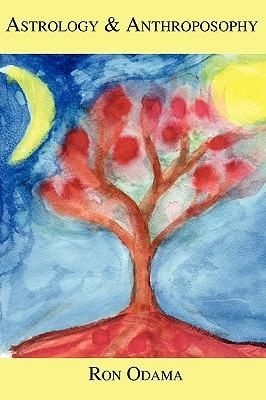
“[In
college] I chose to study psychology and astrology ... [Later] I began
to study Anthroposophy ... I went to work as a Waldorf teacher ...
After two years, we left to start a Waldorf School in South Dakota
... Financial hardships forced the teachers [there] to abandon
Waldorf education ... I [left] to teach Special Education on the Pine
Ridge [Amerindian] Reservation ... After two years I went to work in the
public school system ... [Later] we found a Waldorf school where I
could teach and our children attend ... [Then] I went to work as an
insurance agent/financial planner ... I found a position [at a Waldorf
school] in Kona, Hawaii ... I was forced out due to political
differences ... My last teaching attempt was at a Waldorf school in
Bellevue, Washington. To my dismay I found that the Waldorf school was
not following Rudolf Steiner’s indications ... I retired and began to
devote my time to astrology....” — Ron Odama, ASTROLOGY AND
ANTHROPOSOPHY (Bennett & Hastings, 2009), pp. viii-xi.
Why do horoscopes work? Because at the moment of a child's birth, the stars leave an imprint on the child's brain — an imprint reflecting the stars' unique positions at that moment. Or so Anthroposophists tend to believe.
•
"[I]n the same moment the cosmos leaves a permanent image of itself
imprinted on the brain ... Rudolf Steiner speaks of this ... 'The human
being has within himself an image of the heavens and each has a
different one, depending on the time and place of birth.'" — Elizabeth
Vreede, ANTHROPOSOPHY AND ASTROLOGY (SteinerBooks, 2001), pp. 189-190. •
"[T]he karma of the preceding life expresses itself in the
horoscope, in that it becomes forces that induce a human being to be
born. And equally true is what Rudolf Steiner stated ... 'In that human
beings let themselves be born, they find themselves at home on Earth
according to their individual constellation of the stars.'" —
Ibid., p. 198.
"[A]strology is a highly sophisticated occult science predictive in many areas." — THE NEW STEINERBOOKS DICTIONARY OF THE PARANORMAL (Rudolf Steiner Publications, 1980), p. 17.
The zodiac as displayed at one Waldorf school:
From “First Grade Overview for Homeschoolers”, Waldorf Curriculum, 2006 “When
the child is coming down from heaven, she passes first through the
zodiac and receives her gifts, one of them being the consonants ... This
is the anthroposophical belief.” — p. 25.
“Consonants
Leo - T or D
Cancer - F
Gemini - H
Taurus - R
Aries - V
Pisces - N
Aquarious - M
Capricorn - L
Sagitarius - G
Scorpio - S
Libra - K
Virgo - B or P”
— p. 115.
MEETING THE NEEDS OF THE CHILD TODAY
Lectures from the 2008 International Waldorf Early Childhood Conference Wilton, New Hampshire
Published by the Waldorf Early Childhood Association of North America, on behalf of the International Association for Steiner/Waldorf Early Childhood Education [2009]
In 2008 — during the 21st century, mind — a Waldorf teachers' conference was held to discuss the needs of young children
and how Waldorf education can "meet" those needs. A significant portion
of the conference consisted of lectures detailing the astrological
powers that affect children and their adult caregivers.
Particular
emphasis was placed on the four zodiacal signs that Anthroposophists
believe have special meaning for the guidance of young children. The
point was to help Waldorf teachers understand the significance of
astrological powers for their work in early childhood education.
Children incarnate on Earth through a gradual process, Anthroposophists believe. [See "Incarnation".] Helping children to incarnate properly is often conceived to be a central task for Waldorf teachers. [See, e.g., "Here's the Answer".] At the conference, wisdom such as this was dispensed:
"In approaching the question of the essentials of early childhood education let us begin with four imaginations [i.e.,
true spiritual pictures] of incarnation, which will extend our
thinking out to the Zodiac. Rudolf Steiner has encouraged us to do
so, to look at these pictures of incarnation, if we want to educate
children and especially, one may add, very young children
... On the one hand, out of the cosmos, the Zodiac and the planets,
come those forces which form the child's body in the womb and continue
their formative activity through the first seven years [of
a child's life]. On the other hand, Rudolf Steiner indicates that
there is a continuation of cosmic influences, something like
'archetypal' experiences shared by all children ... [These experiences] are connected to the spiritual qualities behind specific signs of the Zodiac.
In particular, Steiner points to the signs of Aries, Taurus, Gemini,
and Cancer...as powers behind incarnation." — Renate Long-Breiphol,
lecture in MEETING THE NEEDS OF THE CHILD TODAY, p. 16.
The astrological lore presented in MEETING THE NEEDS OF THE CHILD TODAY is
fascinating, particularly because teachers working in the 21st century
are asked to accept it. Very few teachers anywhere except in Waldorf
schools would accept any of it, but Waldorf teachers are expected
to accept all of it. Here is a brief sample, the beginning of the
section on Aries:
"Images of Incarnation
"Aries in relation to the child: The ram looking back
"The image described by Steiner is the ram with his head turned back, a frequent form of depicting the zodiacal sign.
'Looking back' also is one of the gestures of the young child, not
as a conscious act but out of a kind of 'spiritual habit' [i.e., looking back to life in the spirit realm before Earthly birth]. Steiner speaks about the 'telephone connection' which children still hold to the spiritual world." — Ibid., p. 19.
Other astrological
signs, including signs that do not bear specifically on
incarnation, are given similar treatment. A summary of sorts is offered
in these words:
"Openness
to the spiritual world is part of the gesture of Aries, of the
practice of devotion in the face of the spiritual world. Openness and
magnanimity is [sic]
the beginning of the practice of love in the face of the needs of the
earth. Aries and Pisces: these two belong together as the beginning and
ending of the journey through landscapes of the thinking-feeling soul
and the working fields of the will." — Ibid., p. 32.
This is astrology as conceived for the use of Waldorf teachers. It is Waldorf astrology. In the 21st century, mind.
“Not only is a birth horoscope significant but here Rudolf Steiner introduces the conventionally unfamiliar idea that we can equally study the horoscope for the moment of a person’s death.....” — Margaret Jonas, commentary in ASTRONOMY AND ASTROLOGY (Rudolf Steiner Press, 2009), p. 185.
It seems almost incredible that a Waldorf teacher might use a horoscope or offer to create one for a student, and yet here is a report from a mother who sent her child to a Waldorf school [see "Coming Undone"]:
"Many
alarm bells rang during our time there. I remember the intense gaze of
the teachers that would continue far longer than was comfortable. There
was little laughter, everything was carried out in a very slow and
purposeful way with a sing-song voice, the lighting of candles, the
wearing of strange hats, their infatuation with wool — I recall a
felting session where the teacher spoke of the special energy of the
wool, declaring it had come from a biodynamic sheep. I recall the time
the teacher took both my hands in hers and explaining my son had 'chosen
me as his mother,' on a further occasion she stated he had 'chosen the
school' and that children 'get what they need' – ostensibly an innocent
cliché until one understands it's particular meaning within
Anthroposophy. I also recall politely refusing a teacher's offer, made
during a parent and toddler group session, to lend me a copy of [a popular mystical book] and compile an astrological chart based on my son's birth date."
— Compilation and commentary by Roger Rawlings
To visit other pages in the sections of Waldorf Watch that include "Waldorf Astrology", use the underlined links, below.
◊◊◊ 14. PULLING IT ALL TOGETHER ◊◊◊
Mystical thinking, realistic thinking
Reports and advice from parents whose children attended Waldorf schools
A report by a mother who was drawn to a Waldorf school but left disillusioned
Describing the near-collapse of the Waldorf school I attended
Deprogramming myself after Waldorf
Signs of the zodiac as redesigned by Rudolf Steiner and drawn by Imma von Eckhardstein:
Starting at the upper left, we find Pisces, Aries, Taurus, Gemini, Cancer, Leo, Virgo, Libra, Scorpio, Sagittarius, Capricorn, Aquarius.
[Rudolf Steiner, CALENDAR 1912-1913 (SteinerBooks, 2003).]
These images were created to accompany meditative verses written by Rudolf Steiner. Anthroposophists today still use these meditations, known collectively as the Calendar of the Soul.
|
|














